No Wormhole ... No Problem
With the help of Tandon Students, Scientists from NASA’s Jet Propulsion Lab Explore Mars Right from Their Offices

At NASA’s Jet Propulsion Lab (JPL), in California, many of the engineers and scientists are just big kids who’ve retained the science fiction fantasies of their childhoods, Matthew Clausen, the creative director of JPL’s Human Interfaces Group, joked. But while they would love it if wormholes — a staple of old sci-fi films — really existed, the laws of physics make it highly unlikely that travelable tunnels through the fabric of time and space are actually possible.
Clausen is working on a project that might prove to be the next best thing, and students in Tandon Lecturer Dana Karwas' User Experience Design graduate course are helping by prototyping Augmented Reality (AR) navigation tools.
On November 7, Clausen and Marijke Jorritsma (an Integrated Digital Media student who studies with Karwas and works as a JPL research intern) came to the Tandon MakerSpace to discuss the visionary work being done there to transform space exploration, rocket design, and more.
Donning futuristic-looking Microsoft HoloLens 3D headsets, they demonstrated an uncanny virtual reconstruction of the Martian surface (projected onto a screen for the benefit of the large audience) in which NASA scientists can interact using avatars. The re-creation was made using images gathered by the Curiosity Mars Rover. Rather than being bound to their desks, scientists can physically get up and roam through the terrain — a feature that many of them delighted in. “When they first used this, they realized they could run up a hill to get spatial awareness of the scene," Clausen recalled, “and that was one of our first clues that [the project] was going in the right direction.”

Matthew Clausen, the Creative Director at the NASA JPL's Ops Lab, told his audience that immersive technology scored a scientific victory when NASA engineers wearing the headsets did what real-life explorers do: They moved their avatars across the landscape to explore.
In addition to the sheer video-game-like thrill of controlling an avatar, working in the virtual environment proved to be exceptionally efficient. These were data-driven scientists, after all, Clausen reminded the audience. In testing, his group found that researchers were two times more accurate at determining distances and three times more accurate at determining angles between locations when they could look around from within the virtual Martian scene than when they were using conventional algorithmic methods. Using 3D headsets also allows researchers from all over the world to interact in an organic way. The avatar of a NASA geologist working from Pasadena could collaborate with the avatar of a researcher in France, for example.
That ability to collaborate is key to another way in which NASA is using AR: the design and repair of rockets and other equipment. Clausen and Jorritsma described for the audience an application dubbed Project Sidekick, which allows earthbound experts to coach astronauts on the International Space Station through complicated, multistep procedures and repairs by watching the astronauts' actions and overlaying virtual diagrams and instructions onto the equipment in question. That “equipment” might be as prosaic as a stuck door hatch, but it could even include the human body; in one scenario discussed, an astronaut stricken by appendicitis could be treated by a fellow astronaut with guidance from medical personnel back at mission control. With the Space Station limited in size and the number of crew members it can safely host, Project Sidekick, in effect, allows for unlimited extra personnel to “ride along.”
Another exciting application called Protospace lets engineers tinker with virtual true-to-scale models as they design spacecraft and other equipment, eliminating the need for all participants to be in the same room during the design process and cutting down on costly 3D printing. NASA scientists have successfully used Protospace to design a satellite expected to be deployed in 2020 to observe the effect of climate change on the oceans and other bodies of water, as well as a next-generation rover. A special highlight in an evening of highlights occurred when Clausen and Jorritsma demonstrated the rover, showing it from various angles and even dangling it over the heads of the audience.
“There will always be people who want to physically travel to Mars and other faraway places,” Clausen predicted. “But this technology will allow millions of people to stay safely here on Earth yet be untethered ... Anyone who has access to this immersive technology will be able to participate in the exploration of new worlds together.”
Watch the whole discussion and demonstration below:




